ALSACE - Colmar and Hansi the Illustrator
SPECIAL Photo Impression - Year of visit: 2004, 2005, 2007, 2008
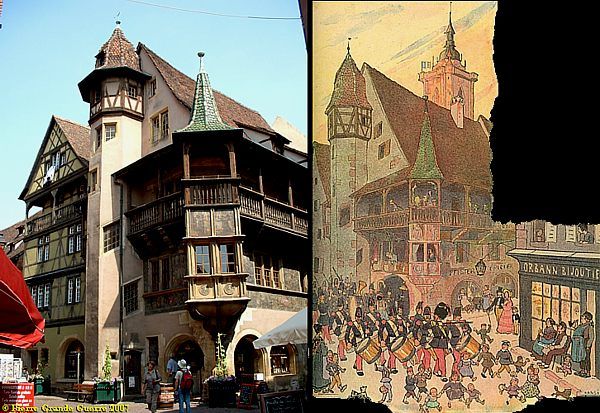
A visit, some 25 kilometres behind the Alsatian front, to the historic city centre of Colmar. Not a battlefield this time, but following some footsteps of his most famous inhabitant, the French patriot, illustrator, caricaturist, and war propagandist, Hansi.
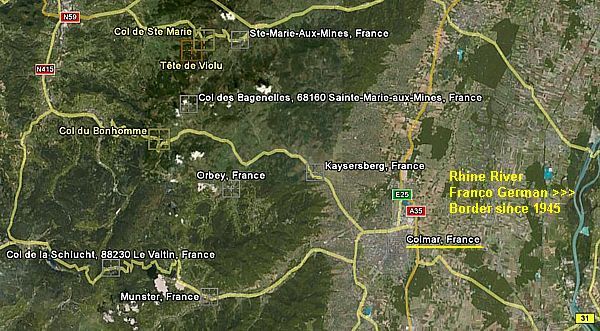
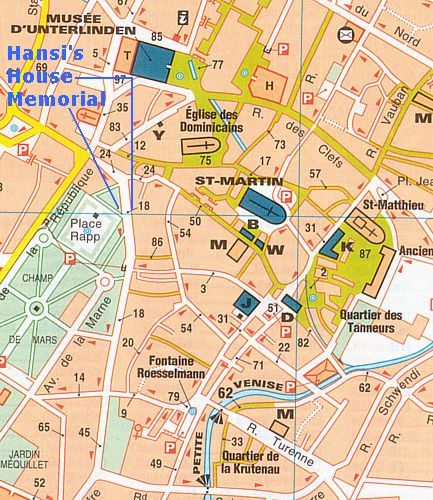
With the life and works of the artist, Hansi, a French Second Lieutenant during the Great War, in our mind, we make a walk through the historic city centre of Colmar.
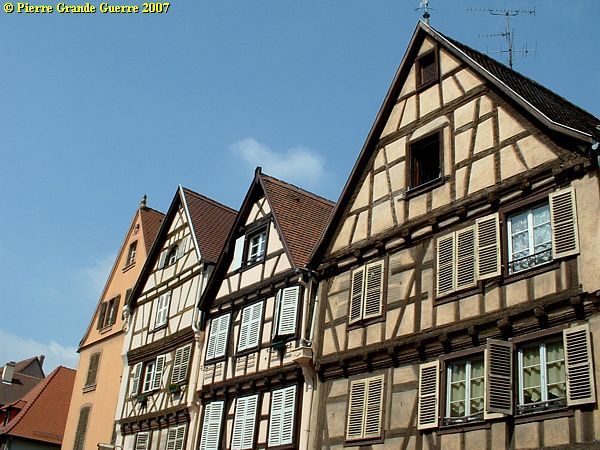
Concise history of Colmar
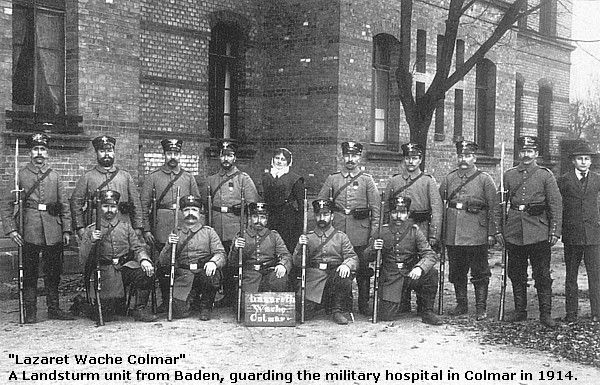
To help you understand the architecture of Colmar, some of the Alsatian culture, and the work of our leading character, Hansi, I would like to sketch you a concise history of Colmar with the emphasis on the period of 1870-1918.
In history Alsace Lorraine, a vital and an important industrial area, has always been a bone of contention for the French and the neighbouring German states. In 1679, while the Thirty Years War was still going on, Colmar was ceded to France in the Treaties of Nijmegen. As a result of the Franco-Prussian War of 1870-1871 the newly formed German Empire annexed Alsace Lorraine and of course Colmar. Alsace returned to France after World War I.
So, from 1870 until 1918 Hansi's Alsace Lorraine and Colmar belonged to the German "Reich" as "Reichsland Elzass Lotharingen". The Germans often called Colmar: "Kolmar".
Though traditionally being used to change authorities, this German "occupation" had quite an impact on the Alsatians.
The Alsatians became German citizens. They had to obey German laws, had to pay their German taxes, and had to enlist under the conscription law in the German Army. The German government encouraged the migration of more Germans into Alsace Lorraine. German became the official language. The German "Kultur" was superior to the French.
These conditions, a proces of " Germanisation", were feeding the nationalism and patriottism of French Alsatians like the young Jean-Jacques "Hansi" Waltz.
Colmar August 1914

Early in the Great War, on 22 August 1914, the French troops succeeded to threaten Colmar at Ingersheim, which is nowadays a western suburbs of the modern city of Colmar.

One of the many units, that were involved in these fights for Colmar, was the 152nd Infantry Regiment, also known as the “Les Diables Rouges", the Red Devils. Our leading character, Hansi, then still a corporal, was serving in this unit.
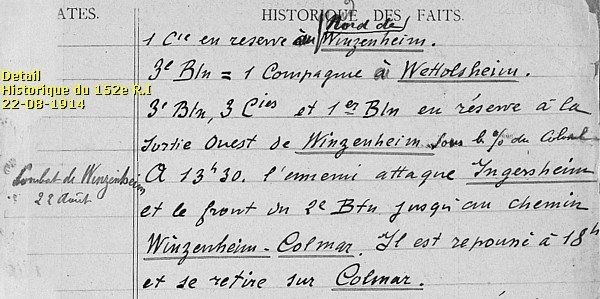
Members of the Bayerische Landwehr Infanterie Regiment 1 managed to stop the French advance at Ingersheim. The main force of the Germans withdrew on Colmar.
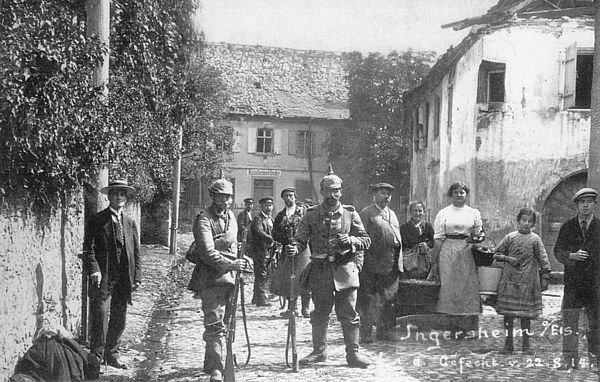
Though a weak unit of French Cavalrists knew to reach the centre of Colmar on 23 August 1914.
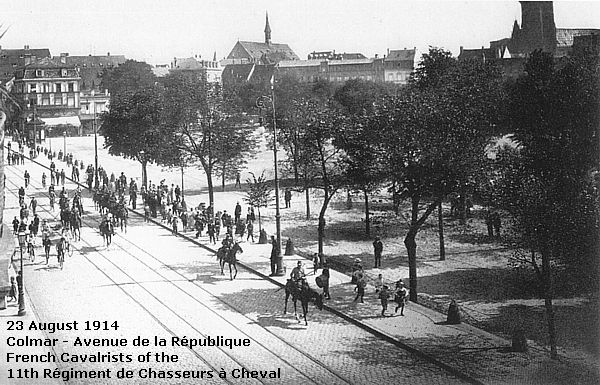
From the 28th the Germans drove the French troops back westward to a frontline, running roughly from Wintzenheim to Katzenthal. For the rest of the war Colmar would remain in German possession. In a matter of weeks the Germans forced the French to withdraw more westward, on the ridges of the Vosges.
Alsace Lorraine and Colmar
returned to France after the Great War, were annexed again by Nazi
Germany in 1940, and then reverted to the French authorities in 1945
after the battle of the "Colmar Pocket" .
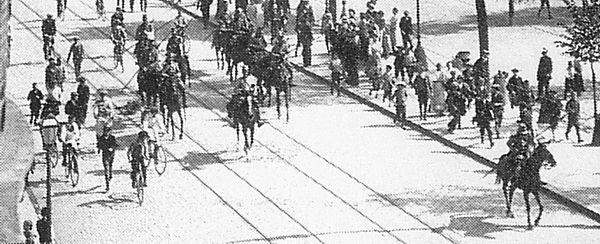
We start our walk southwest of the Saint Martin at the Place de l'Ancienne Douane. My late wife Christ ( + 08-05-2018 ) stands in front of the Schwendi fountain, made by Bartholdi.
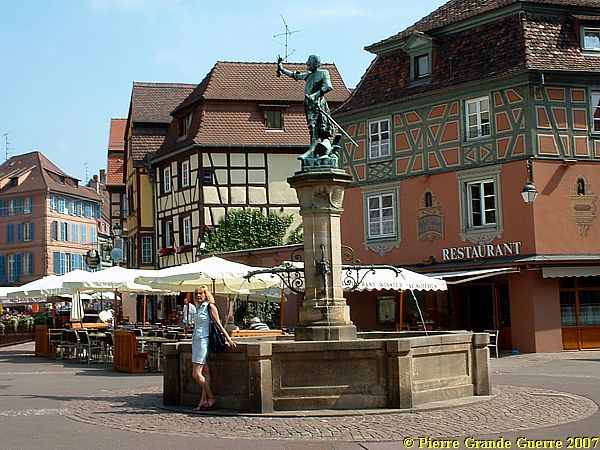
After all these centuries of hostilities and changing nationalities, in the unified Europe of nowadays both the German and French cultures have blended nicely together into a pleasant mix and life style.
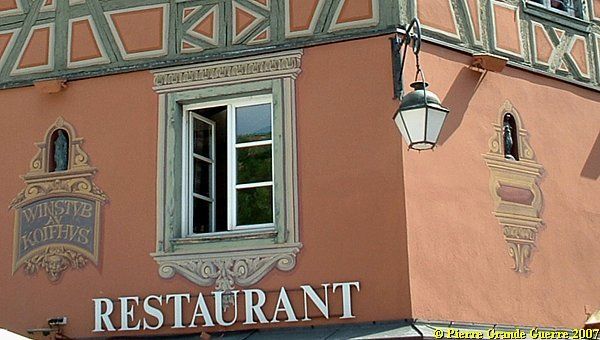
You will recognise this rich Franco German culture mix in the baroque buildings, like "Le Koifhus", l'Ancienne Douane
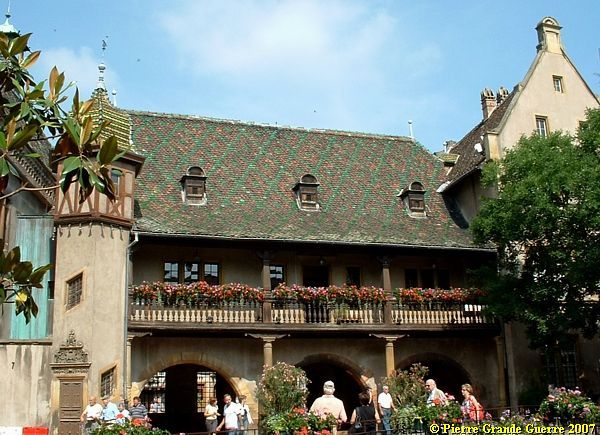
"Koifhus" means "Kauf Haus", l'Ancienne Douane, the old custom house used to be the centre of trade administration.
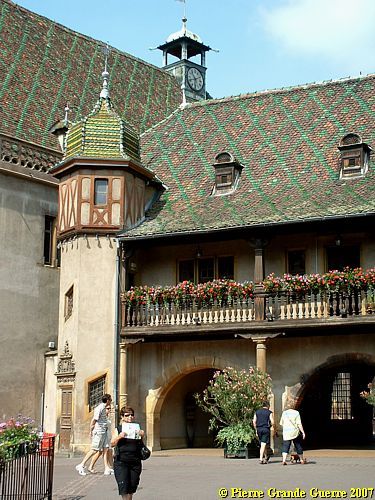
View from Place de l'Ancienne Douane to the Quartier des Tanneurs.
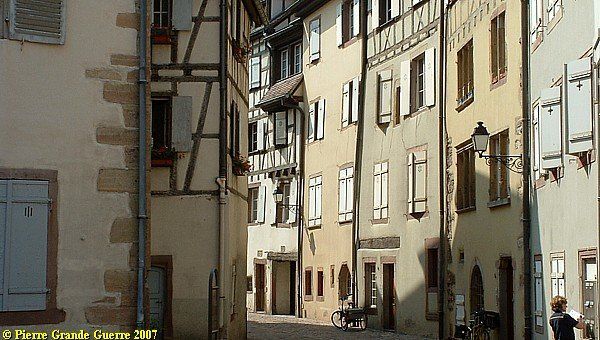
View from Place de l'Ancienne Douane to the Grande Rue.
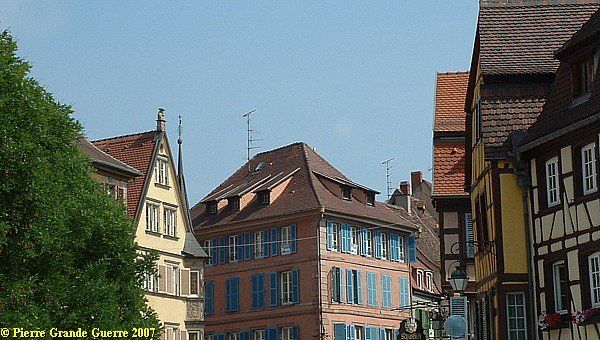
French style and German style fronts are mixed and alternating each other.
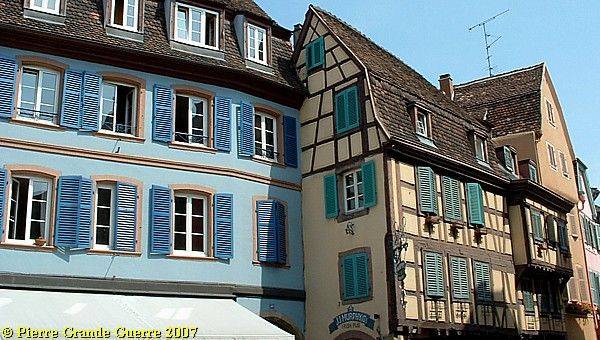
In the Rue des Marchands we find our first reminder of Hansi.
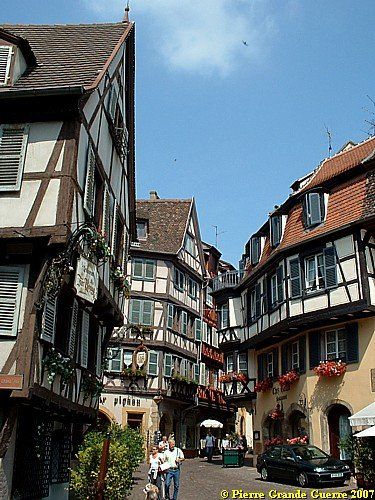
The owner of the "Chez Hansi" Restaurant adopted Hansi's reputation.
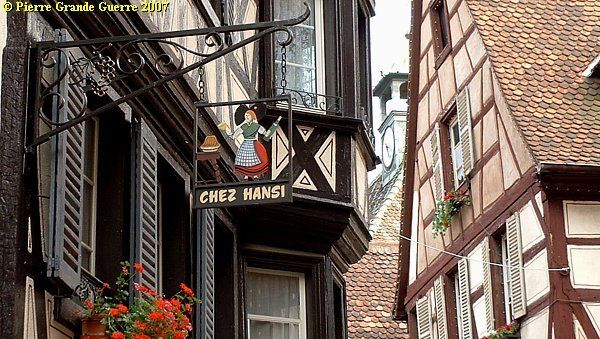
The menu offers also some typical Alsatian dishes...
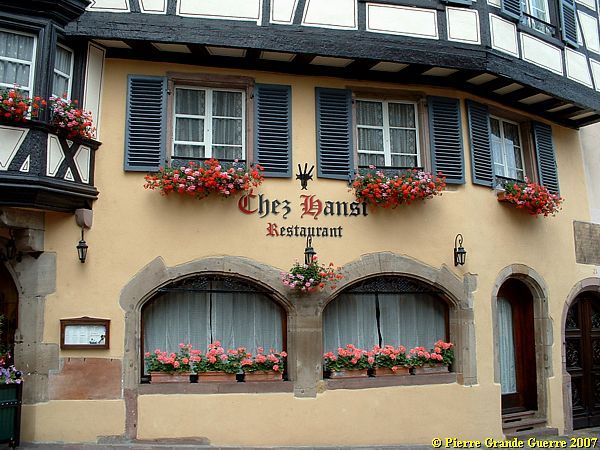
... like the famous "Choucroute à l'Alsacienne", a lushful sauerkraut dish of Franco German origin.
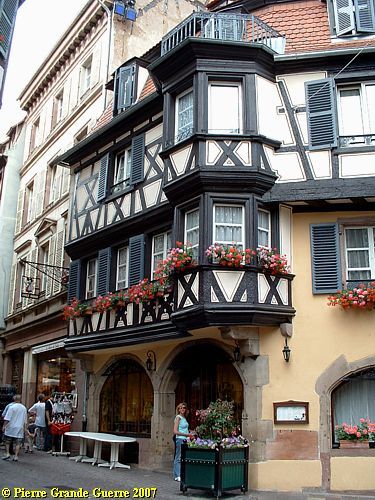
Hansi designed a postcard with at the back the recipe for this dish.
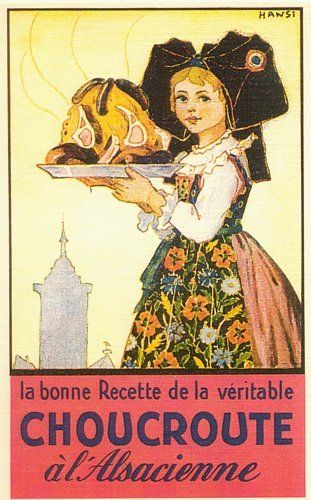
Rue des Marchands and in the background the tower of the Cathedral of Saint Martin.
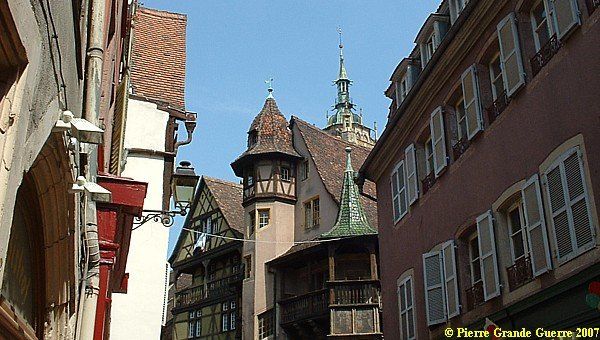
Maison Pfister is one of the most beautiful townhouses in Alsace and a landmark in Colmar.
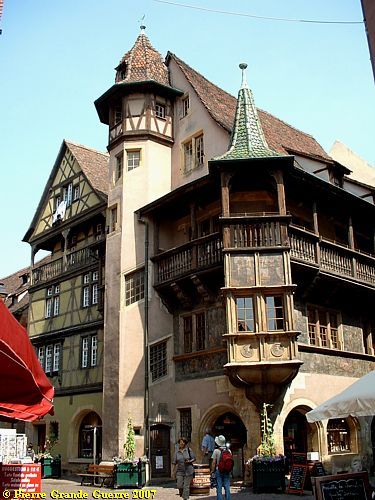
Maison Pfister is named after a previous owner of the 19th century. The house was built in 1537 for the hatter, Ludwig Scherer. The architecture is still medieval, but the decoration of the facade is in Renaissance style. The paintings depict Habsburg Emperors of the 16th century, evangelists, and bible scenes.
In one of his books, " The History of Alsace, told to little children by Uncle Hansi ", Hansi also aquarelled the Maison Pfister, relating to the events of 1870 in Colmar during the Franco-Prussian War.
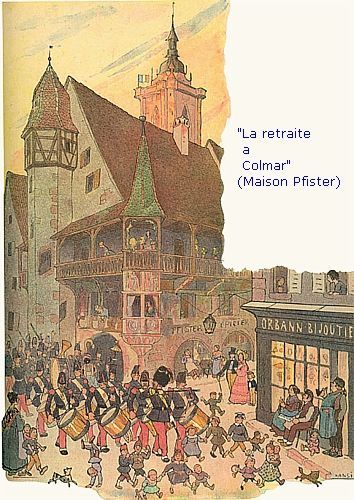

Perhaps a portrait of the hatter, Ludwig Scherer?
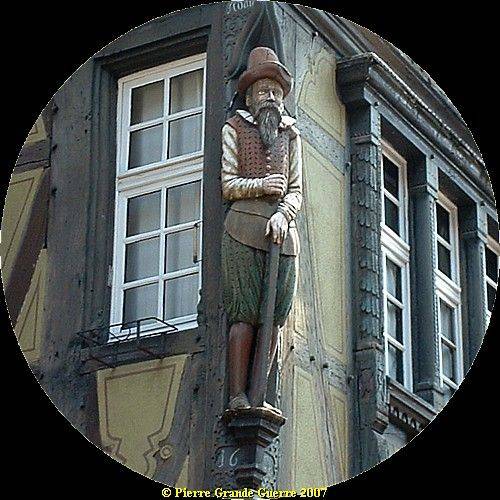
At the Place de la Cathédrale we find the Cathedral of St. Martin.
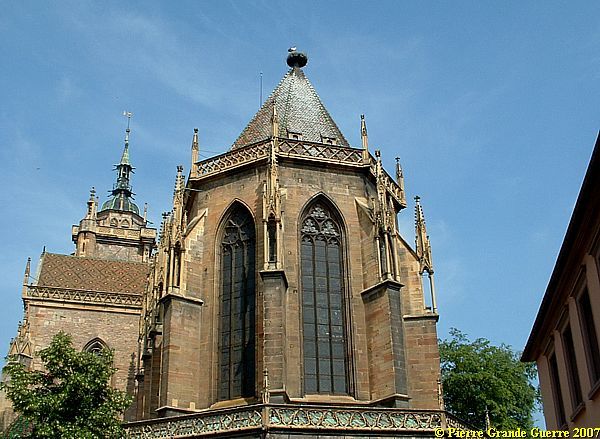
As in all small villages in Alsace, the storks have also here in Colmar their own nest on the roof of the church. "Martin" and "Martine" are guarding their little ones and the city.
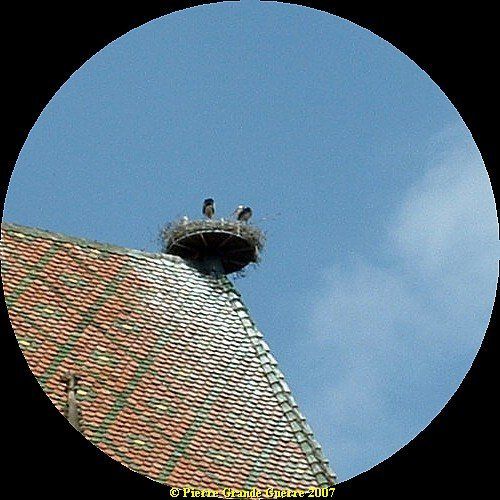
Storks are the national symbol of Alsace. The stork is also an important theme in Hansi's illustrations.
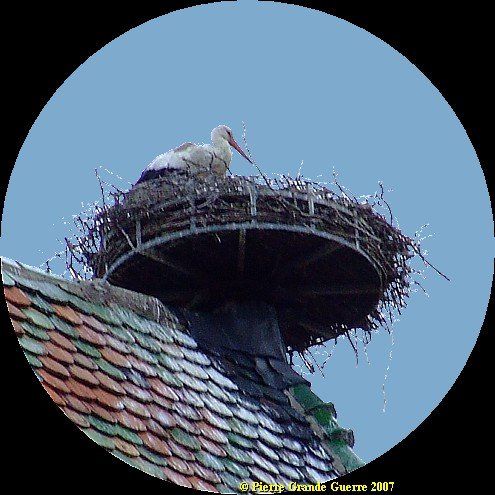
At the end of the Rue des Marchands we go right to the Boulevard des Champs de Mars.
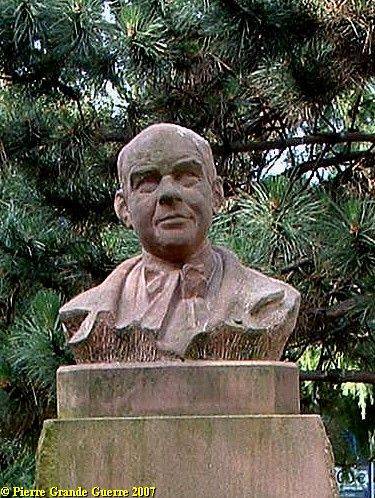
At the corner with Place Rapp stands this memorial bust for Hansi.
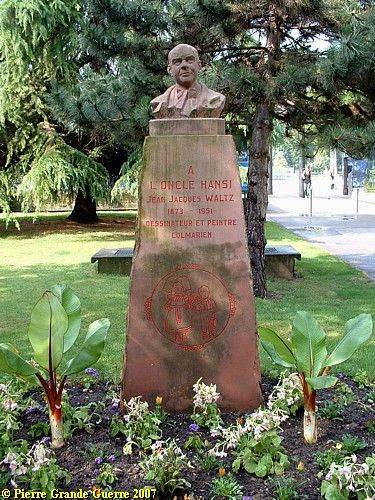

Opposite the Hansi memorial, at the other side of the street at number 9, the house where Hansi lived from 1921 until his death in 1951.

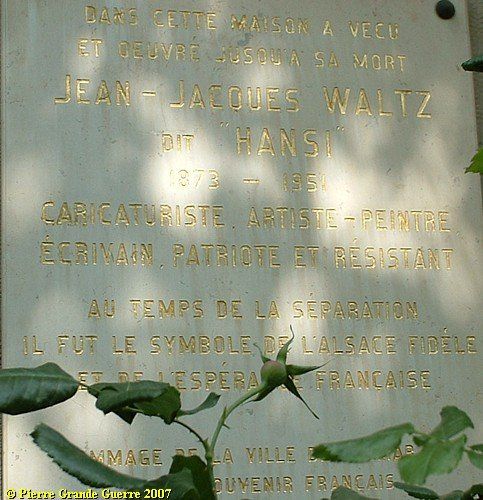
Jean-Jacques "Oncle Hansi" Waltz (1873-1951)
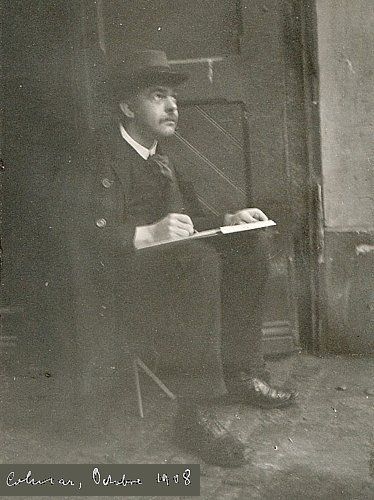
Hansi ("Little John") was born as Jean-Jacques Waltz on 23 February 1873 in Colmar, a town in Alsace, which at that time belonged to the German ""Reichsland Elzass Lotharingen". After the Franco Prussian War of 1870-1871 the Germans stipulated, that the raw materials and industrial richness of Alsace Lorraine again belonged to the brand new "Kaiser Reich". After their loss of the war the French experienced above all the loss of their Alsace Lorraine as a deep humiliation, which would continue until 1918.
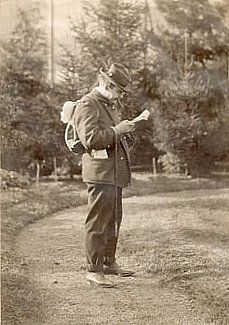
Hansi was already during his schooldays showing his deep aversion to the prevailing Pan Germanism in drawings and cartoons. During that period Pan Germanism was in full bloom under the direction of the Kaiser. During these days as a youngster he already irritated the authorities.
Hansi often liked to wander around in the beautiful landscape of Alsace making sketches and drawings of the picturesque villages.
Professor Knatschke
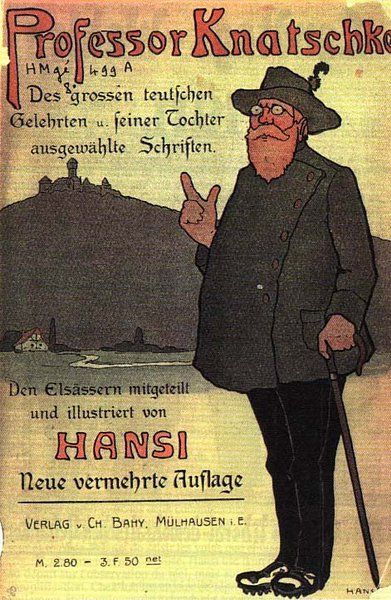
In 1908 Hansi published his satiric novel, "Professor Knatschke", criticising the Germans with his texts and caricatural illustrations. This is the cover of a version in the German language.
This book, indeed, was a revelation. His favorite character, the German Gendarme.
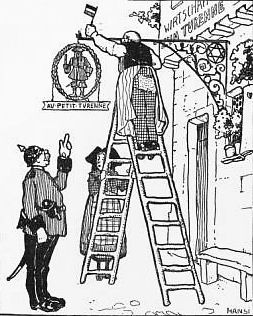
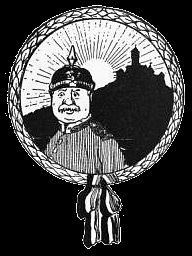
Never had the Germans been so wittily ridiculed.
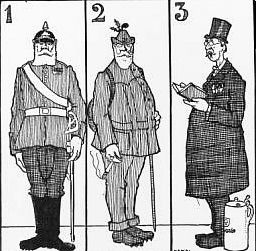
Professor Knatschke, visits, as a German Tourist, the Louvre Museum in Paris. Hansi introduces also one of his most favourite themes: German Tourists.
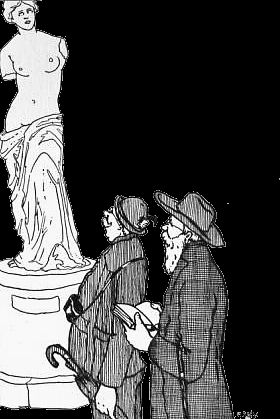
Hansi's written observations are satirical and rather vicious, though Hansi avoids excess in his black and white caricatures.

L'Histoire d'Alsace racontée aux petits enfants par l'Oncle Hansi
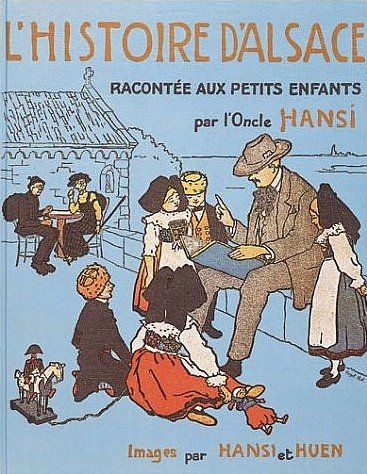
In
1912 Waltz published "L'Histoire d'Alsace racontée aux petits
enfants par l'Oncle Hansi",
"The History of Alsace, told
to little children by Uncle Hansi".
Hansi tells the history of Alsace. His text possesses a firm French, patriotic, and anti-German view point. Though being a book meant for children, the political message of the illustrations is clear.
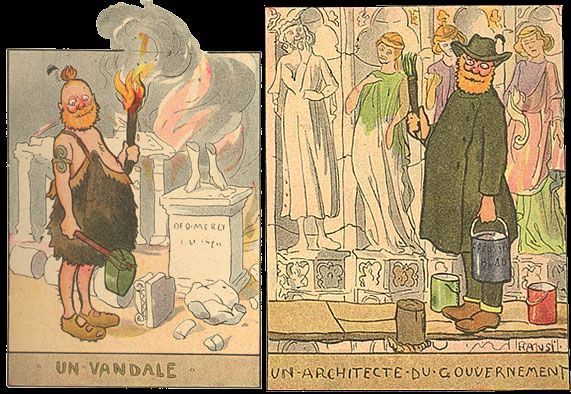
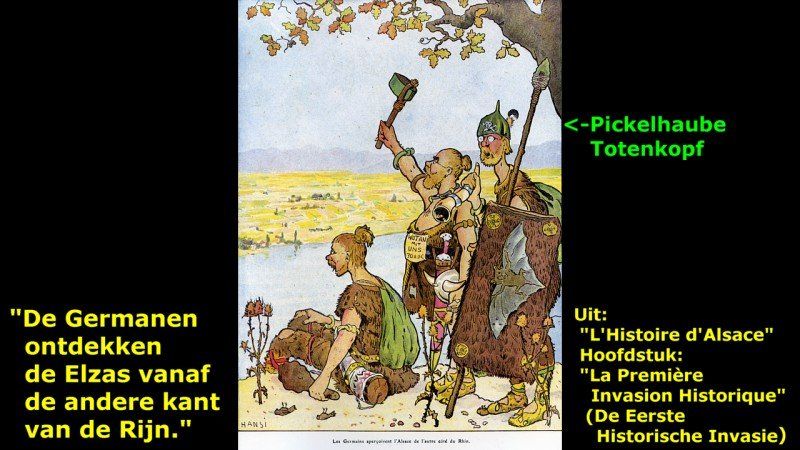
Quote accompanying this picture:
"But the people of Baden then had another speciality, and as soon as the hordes arrived near a farm in Alsace, they looted the lower court. They took everything, but they especially preferred eggs. They made enormous omelettes, which they described as colossal, and so great for to go faster, they broke the eggs with their feet. Since that time they are called in Alsace: "Men with egg yolk feet" (in Celtic Galfiesla)."
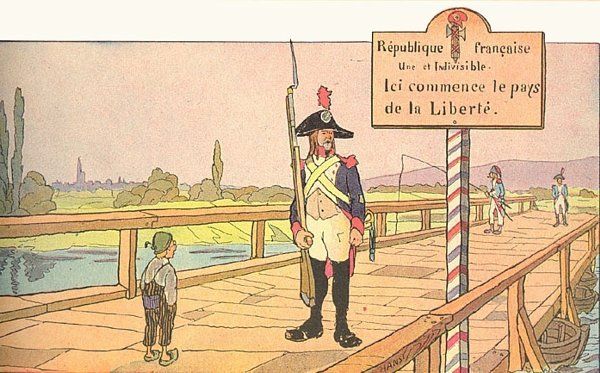
Hansi shows German soldiers of every period in the Alsatian history, always equipped by the spoils of war, and always a clock under their arm.

This
book, but also his later books and postcards, is full of small,
corrosive, caricatured jokes about Germans, a political reference of
Waltz's aversion to the Germans and their Pan Germanism.
"The
Huns for Strasbourg", Hansi's co-author and illustrator Huens' interpretation of the events in
1870.

Hansi criticises the growing immigration of German inhabitants in Alsace.
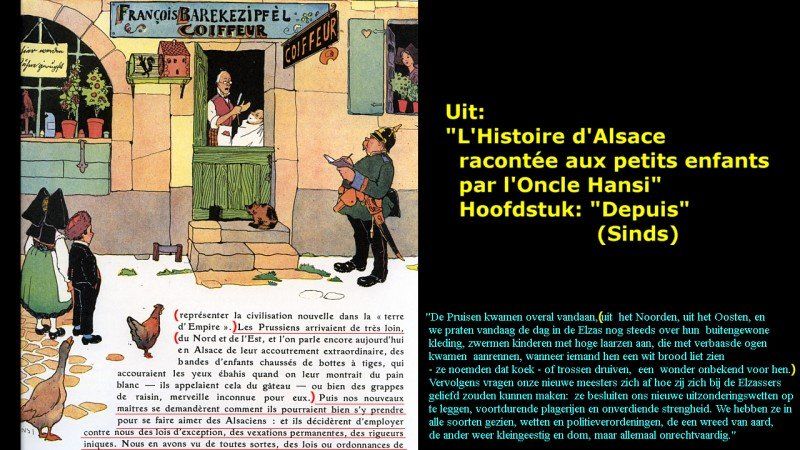
Hansi shows his irritation about the presence of the German military.
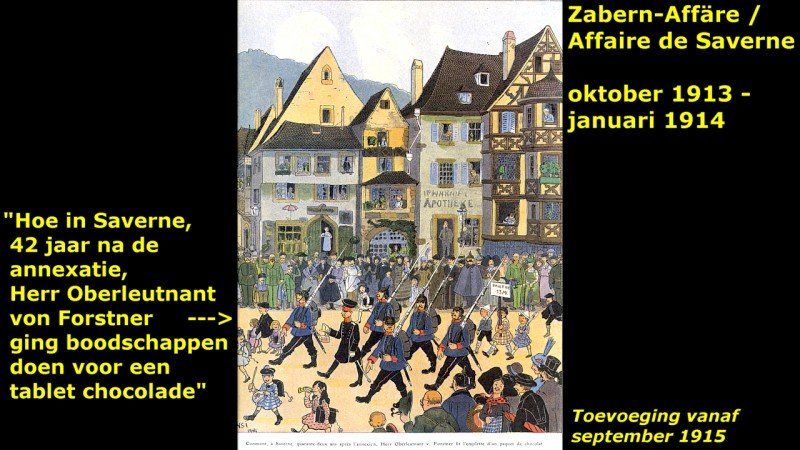
About the period after 1871 : the arrival of German immigrants in Alsace.
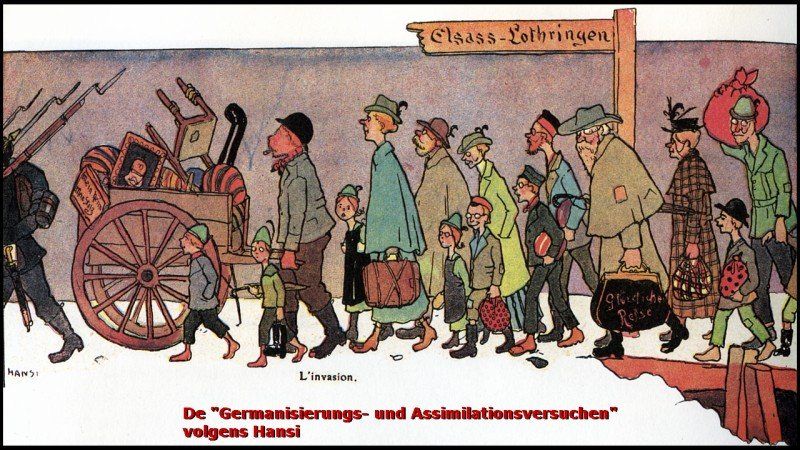
The arrival of German tourists in Alsace.
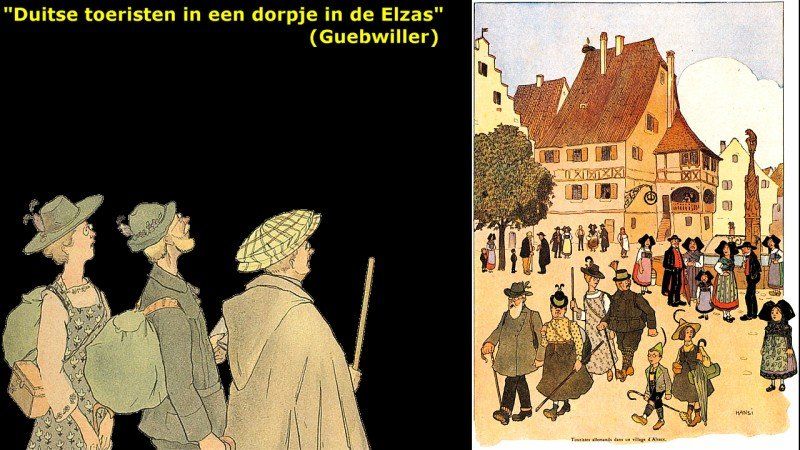
For postcards he also drawed caricatures of German Tourists in Paris.
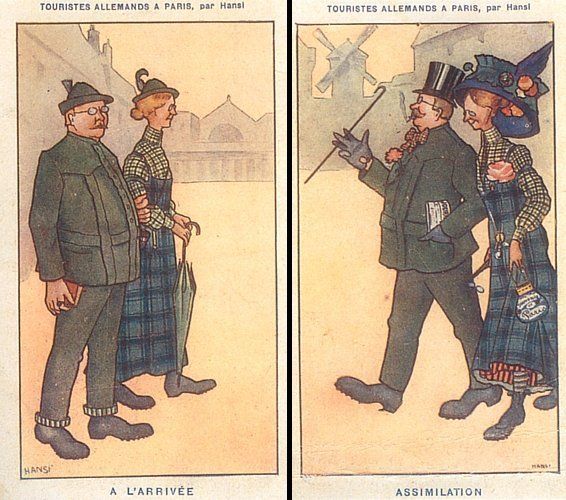
Mon Village
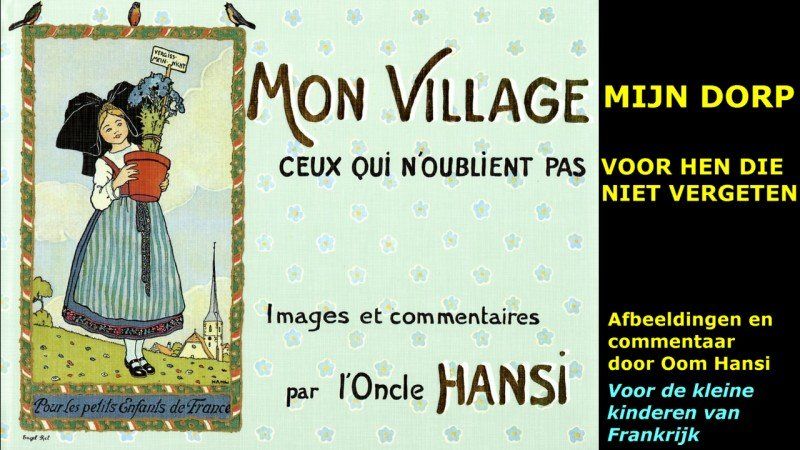
His drawings with a critical wink to his society, and especially his book of 1913, "Mon Village - Ceux qui n'oublient pas", "My Village - For those who not forget" , were bringing Waltz into serious trouble with the German authorities. This book for children is illustrated with romantic drawings of playing children in the villages of Alsace. But in his details Hansi is always mocking the German village gendarme.

Hansi's villages are almost always overlooked by the national symbol of Alsace, the proud stork, "Le Cigogne", on it's nest on the roof of the church.
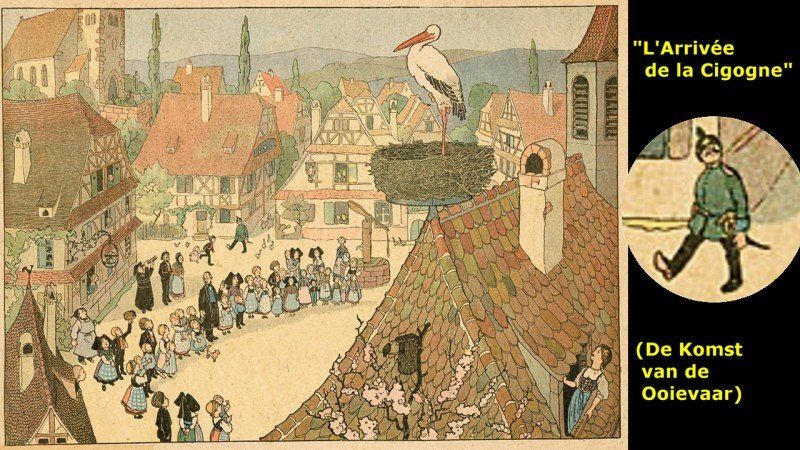
A "Prussian" teacher educates the French children of Hansi's village in German.
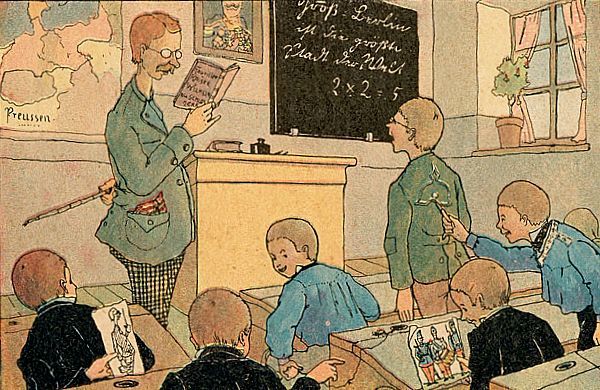
Troubles with the German authorities
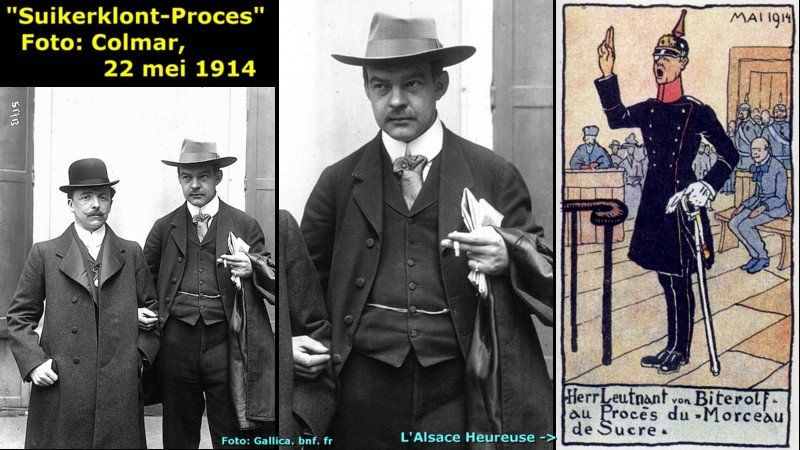
The German government dragged Waltz, as one of the members of the nationalist group of "Les Revanchards", into Court. First for the Tribunal in Colmar, and later to the Court in Leipzig! Because of his mockery of German officials, including police officers and teachers, the court condemned Waltz in July 1914 to one year imprisonment.
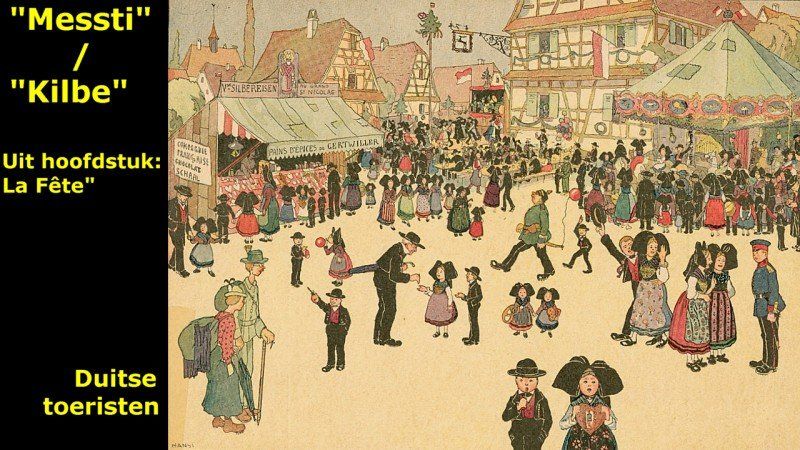
Hansi's "Mon Village" and his other books, drawings, and paintings were "deutschfeindlichen Karikaturen" and showed an "anti-deutschen Haltung".
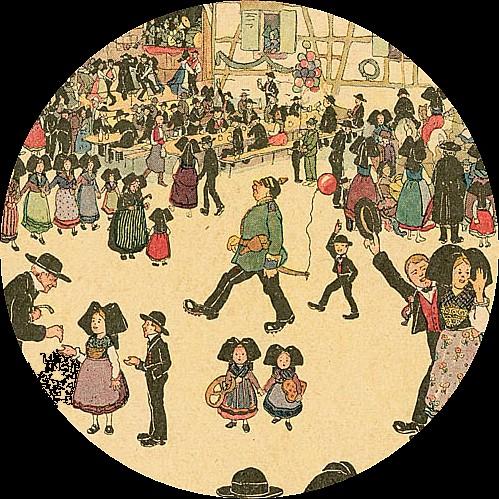
This caused a national outrage in France, making headlines in newspapers, ...

...and inspiring Clemenceau himself to write two editorials in his magazine, "L'Homme Libre".
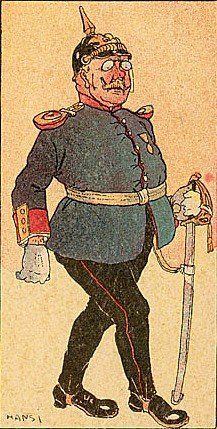
Also in "Mon Village" Hansi plays with his favourite theme, the German Tourists.
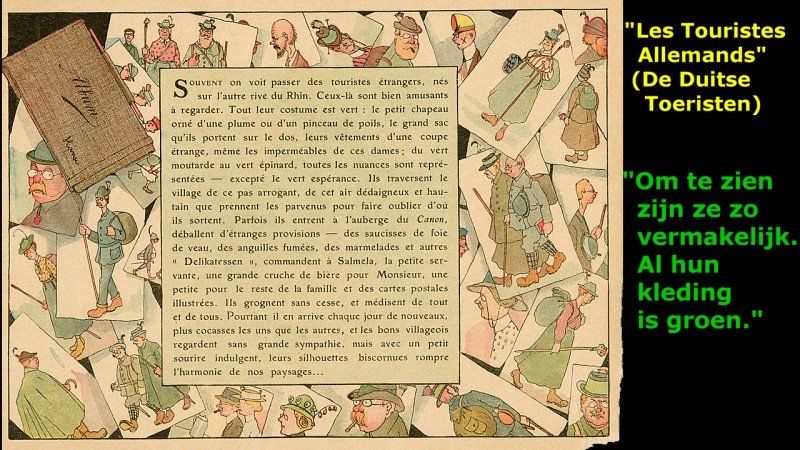

This time Hansi shows also the arrival of well clothed French tourists, ...

... their visit to Hansi's village, ...
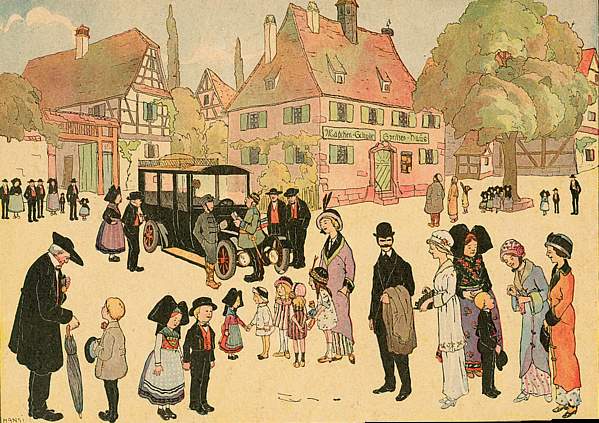
... and a German officer arguing with the driver of the car.

For fellow front travellers a recognisable image: The Alsatian children of Hansi's village visit a French memorial and the battlefields of 1870. Gretel holds a garland under her arm.
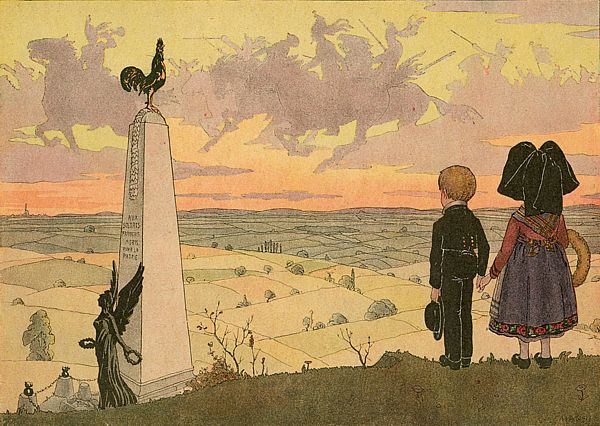
Hansi's Escape

During his trip back from the Leipzig Court to Colmar Waltz managed to escape the German bureaucracy.
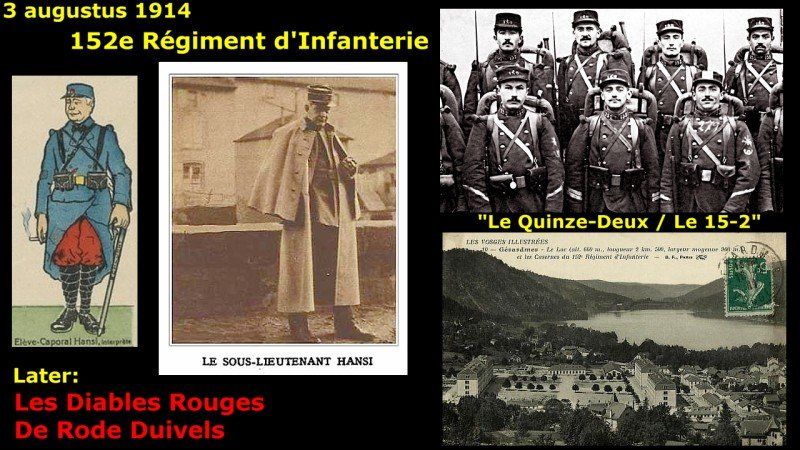
Hansi fled to France, where he immediately enlisted in the famous "Quinze Deux", 15-2, the 152nd Infantry Regiment, as a corporal, soon to be promoted to Second Lieutenant and interpreter of the General Staff of the 41st Infantry Division.
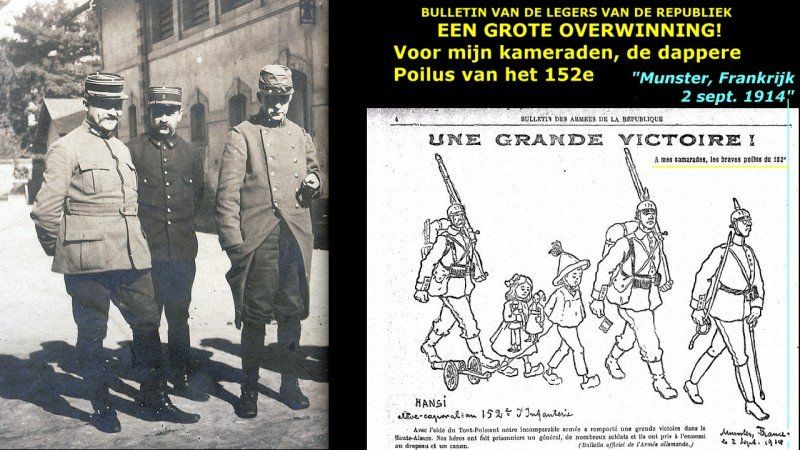
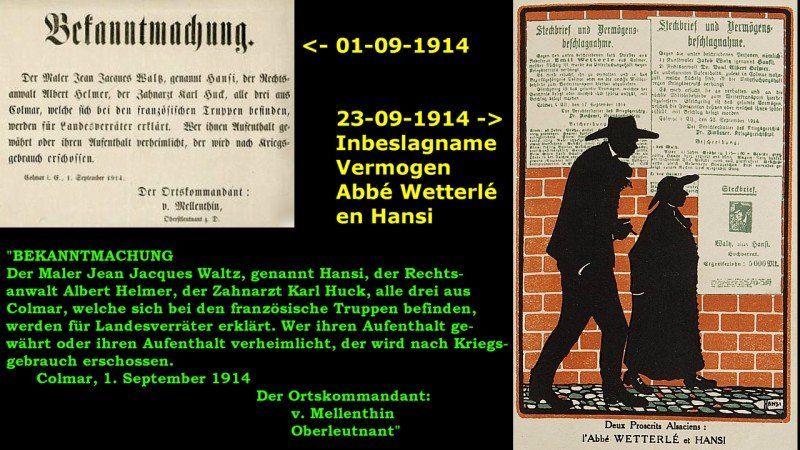
On 1 September 1914 the German government in Kolmar announced on placards, that
"The painter, Jean-Jacques Waltz, called Hansi", and two other notables from Colmar, "who are to be found amongst the French troops, are declared traitors. Anyone who knows of their residence, or is hiding them in his residence, will be shot after war custom. Der Ortskommandant Kolmar, Oberleutnant von Wellebin".
Portrait of Jean-Jacques Waltz in 1917
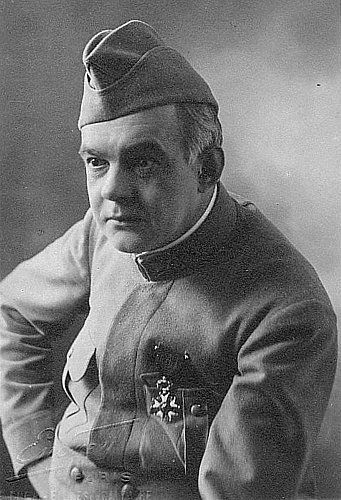
During the Great War Hansi went on illustrating, especially propaganda postcards. The liberation of an Alsatian village in August 1914 inspired Hansi in August 1918 to make two illustrations for postcards. Hansi commented afterwards : "A village somewhere between Thann and Wesserling on 4 August 1914, the first day of the war."

Hansi: "The same village during the French liberation on 10 August 1914. Everybody is happy, even the stork on the roof of the school is in a good mood."
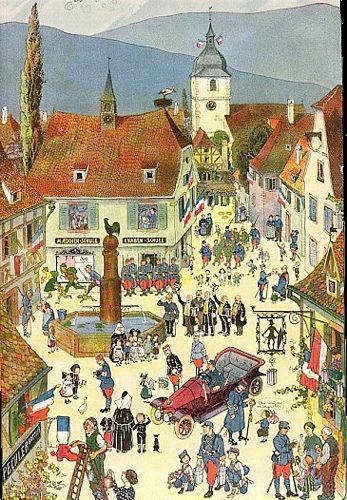
The allied victory at the Battle of the Marne inspired Hansi also.
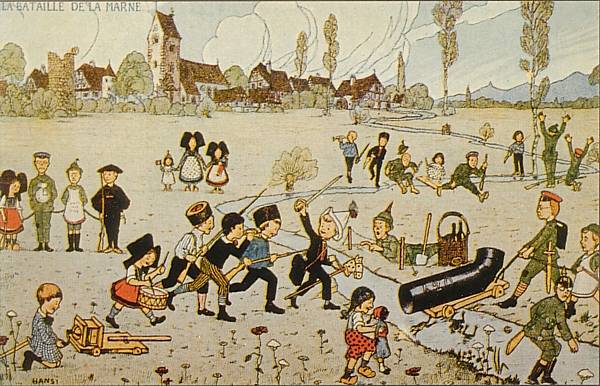
Hansi inscripted the kid's artillery gun with "420", referring to the German canon bombarding Paris.
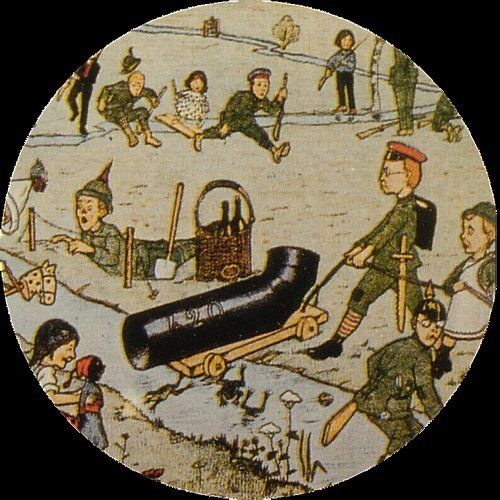
A variation on the theme of the German Tourist, or the German citizen.
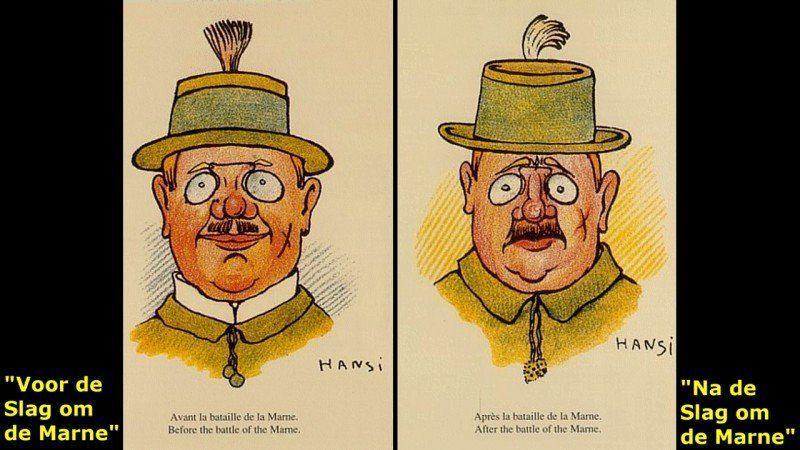
Hansi is referring here to the French successful advances in some parts of Alsace, like in the Munster Valley around Metzeral.
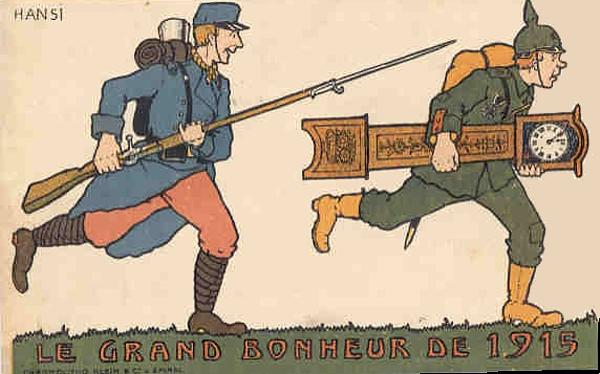
Hansi's caricatures became more nastier. Another favourite theme of Hansi returned: the looting German soldier with a huge clock on his back.
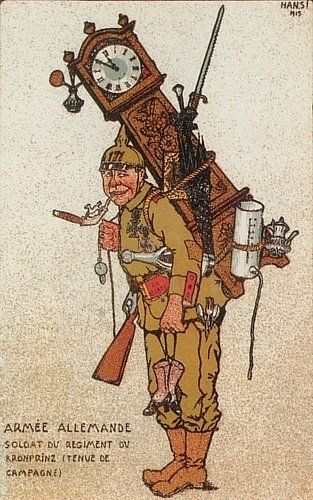
The German Crown Prince, who Hansi calls "the micro-brained megalomaniac", is wearing four Iron Crosses.
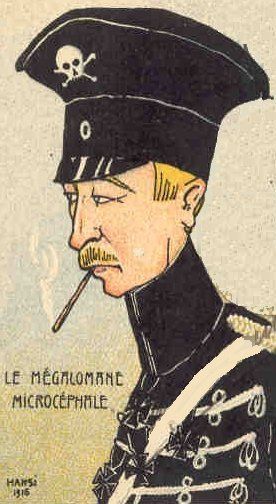
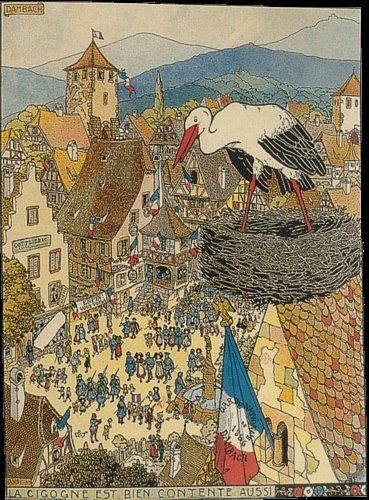
The soldiers are wearing helmets and "horizon blue" instead of their red pantalons.
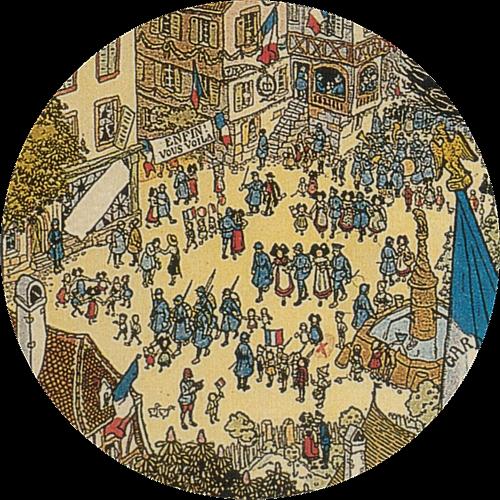
But Hansi of course never forgot to educate his little Alsatians and other French children into obeying, but before all, patriotic, French citizens!

At Chatenois (near Sélestat) a Poilu is even teaching the children "A French Lesson", ...
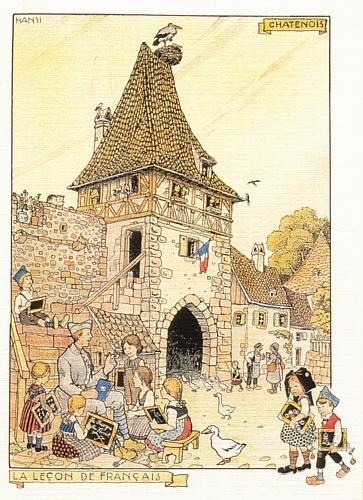
... of course about the "Cigogne", the stork.
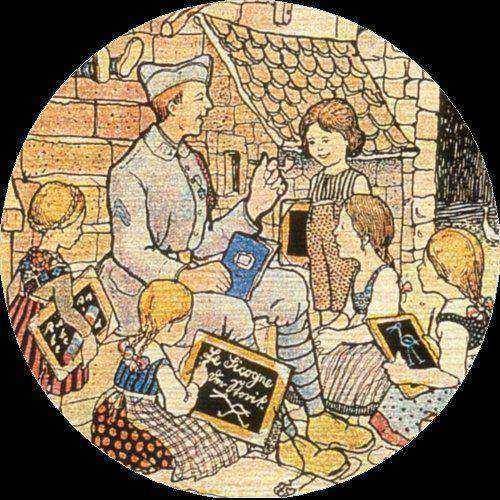
"La petite Alsacienne", Gretel, with Uncle Hansi's doll, ...
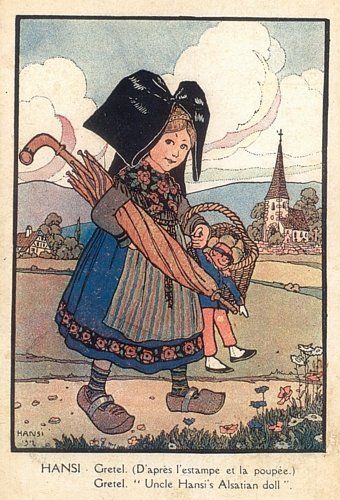
... indeed a Poilu in 1914 style uniform.
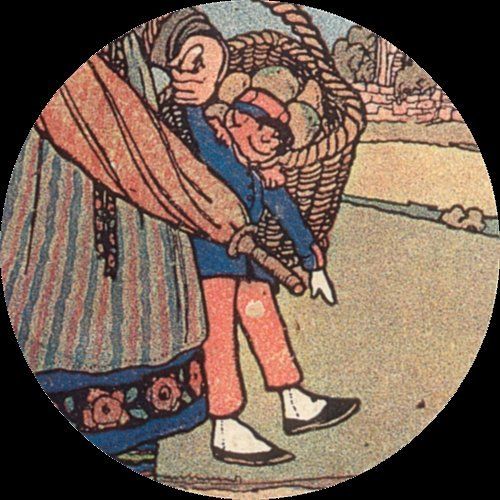
In
November 1918 Waltz entered triumphantly his hometown Colmar with his
Red Devils, his 152nd Infantry Regiment.
After
the Great War Hansi returned to live again in Colmar.
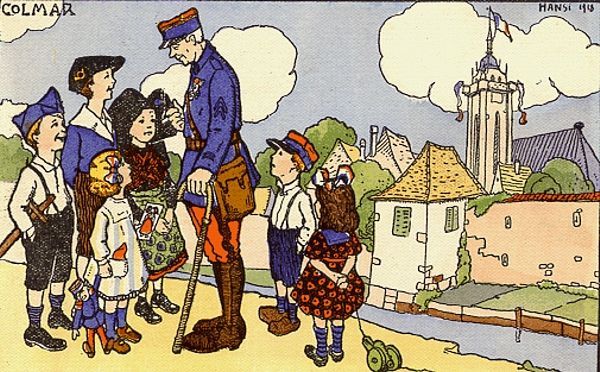
Hansi in the Second world War
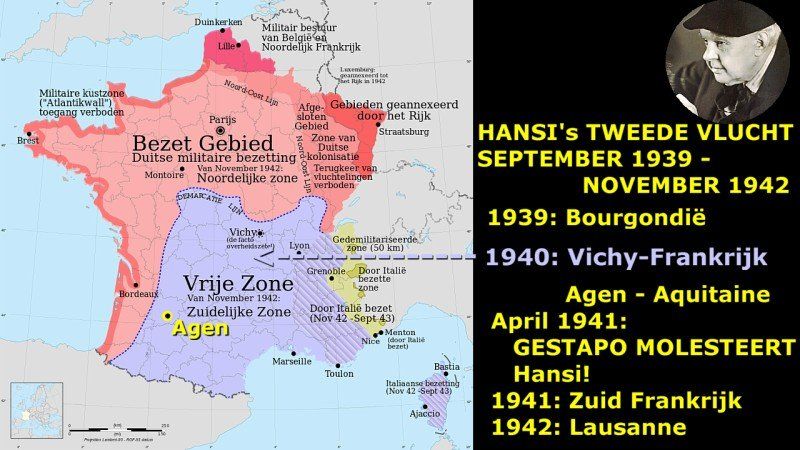
But in 1940 Jean-Jacques Waltz was forced again to escape from the Germans to the "free" Vichy zone. But the revengeful German authorities had not forgotten him. In April 1941 the Gestapo succeeded to find Hansi in Agen, where they molested him seriously at night in front of his home. The Gestapo assumed that Waltz was dead, and left him for dead behind. Hansi managed again to flee again, this time to Switzerland. Until his dead Waltz would still suffer from these injuries.
In 1945, when Colmar became again French, he returned home. 0n 10 June 1951 Oncle Hansi Waltz, died of old age (78) at his home on the Boulevard du Champ de Mars. During his life Hansi has been awarded with the title Commandor of the Légion d'Honneur, with the Croix de Guerre 1914-1918 with palms, and the Croix de Guerre 1939-1945 with palms.
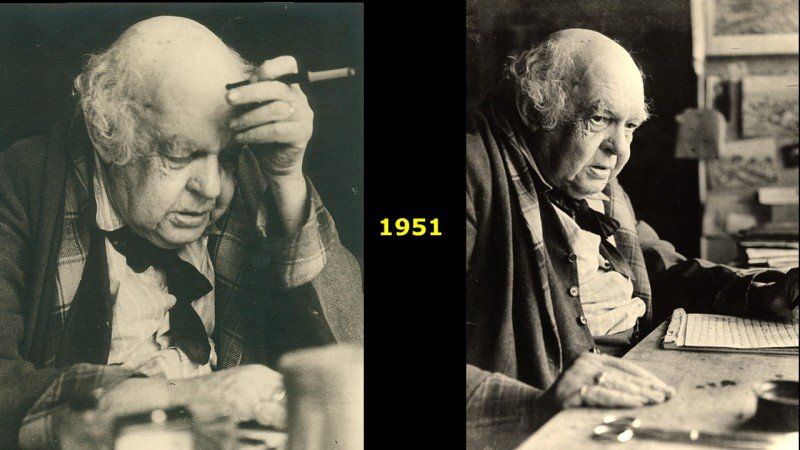
|
"Oncle Pierre" has told his guests quite enough about Hansi. Before "Oncle Pierre" will use further less words for his comments, and before he leaves you to view the rest of the pictures of Colmar, some last remarks about this Hansi phenomenom in our own modern times. Hansi products are nowadays a part of Alsatian folklore and also of Alsatian merchandising. In every tourist shop in Alsace you will find a lot of Hansi gadgets; from postcards and calendars, to plates, and towels, anything you like with a Hansi print. I do realise, that I am not showing you here all the tourist highlights of Colmar, like for instance the Unterlinden Museum. I prefer to continue the rest of this photo impression with photo's of Colmar in daily life and concise comments. Dutch Readers , Lees ook voor meer details over Hansi's biografie en over zijn boeken mijn lezing. " Oom Hansi - Kindervriend en Moffenhater "! |

We continue our walk through Colmar through the Rue des Têtes.

Rue des Clefs. Hansi was born at number 41.
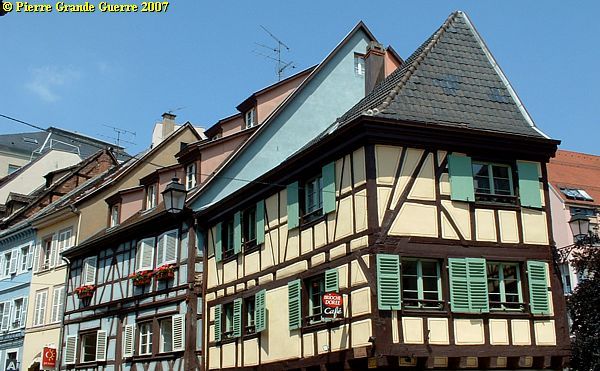
Grande Rue.

Colmar possesses al lot of pubs and restaurants.
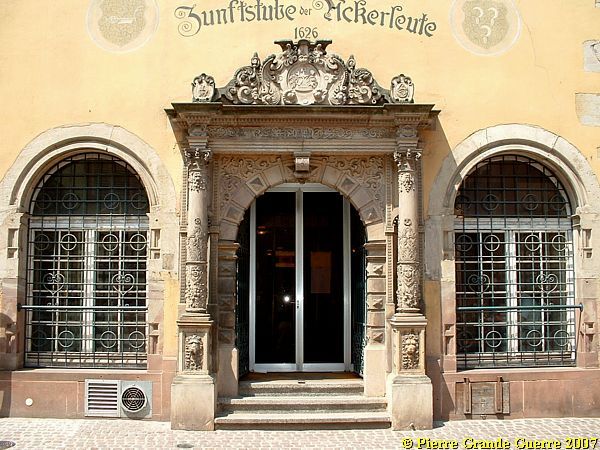
In the neighbourhood of the Rue St. Jean.
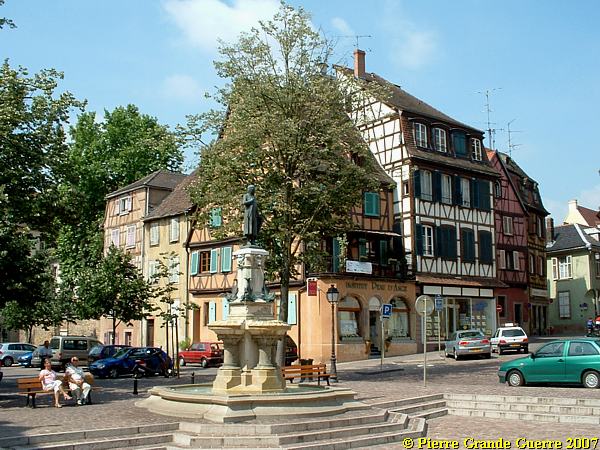
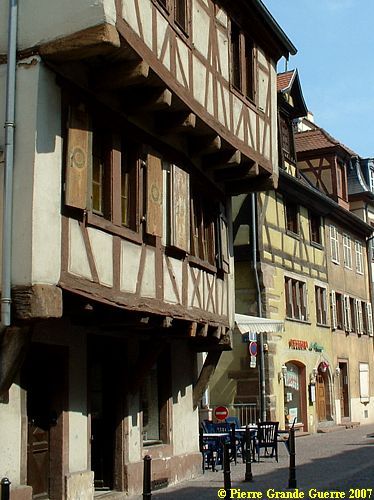
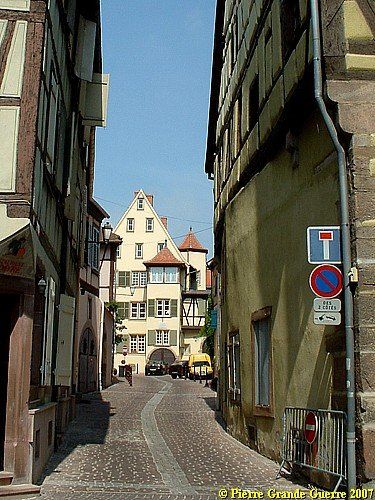
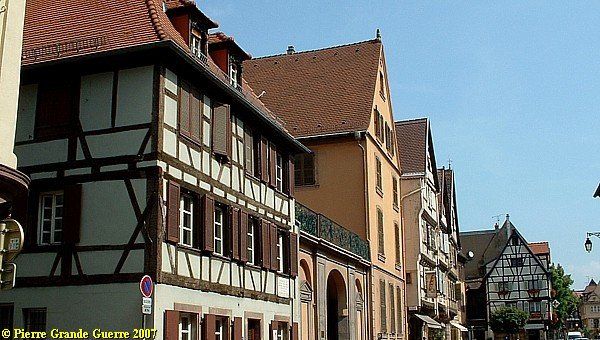
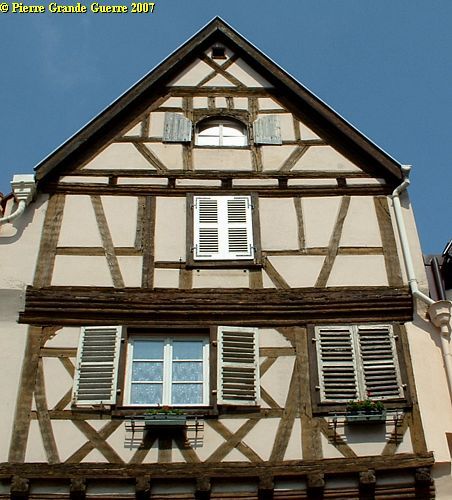
The last pictures are from the Quartier de la Petite Venise, "Little Venice".
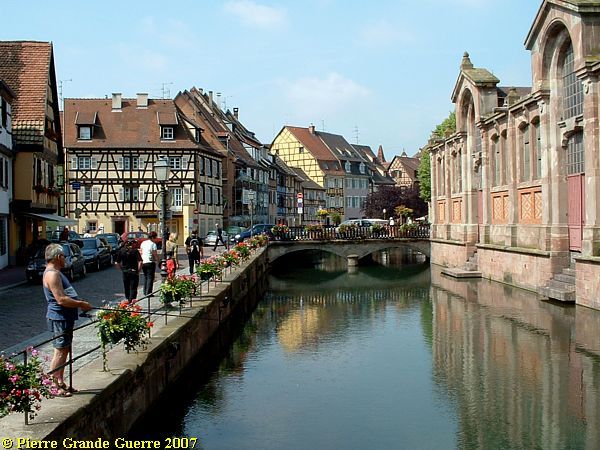
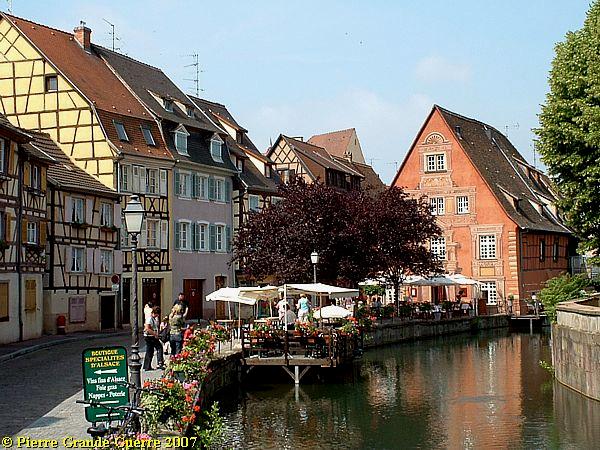
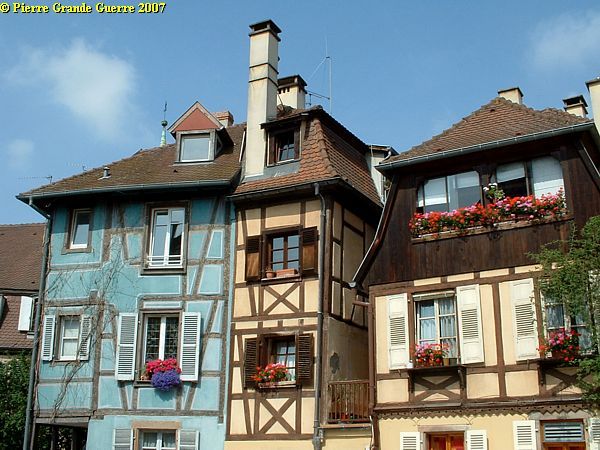
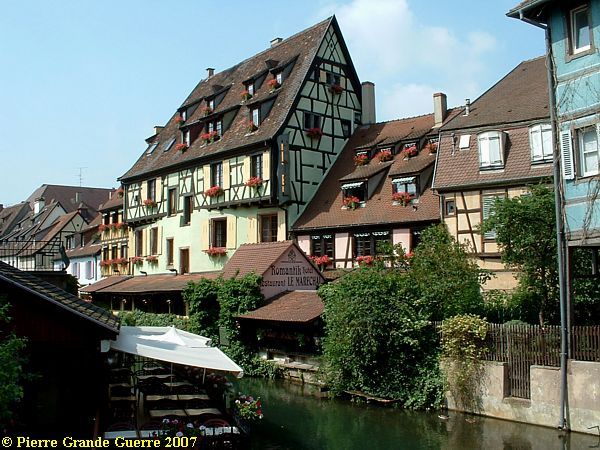

Continue
to the next Special Photo Impression: " Armistice Clearing
- Clairière de Rethondes - Compiègne"
Dutch Readers
, Lees ook voor meer details over Hansi's biografie en over zijn boeken mijn lezing. " Oom Hansi - Kindervriend en Moffenhater
"!










